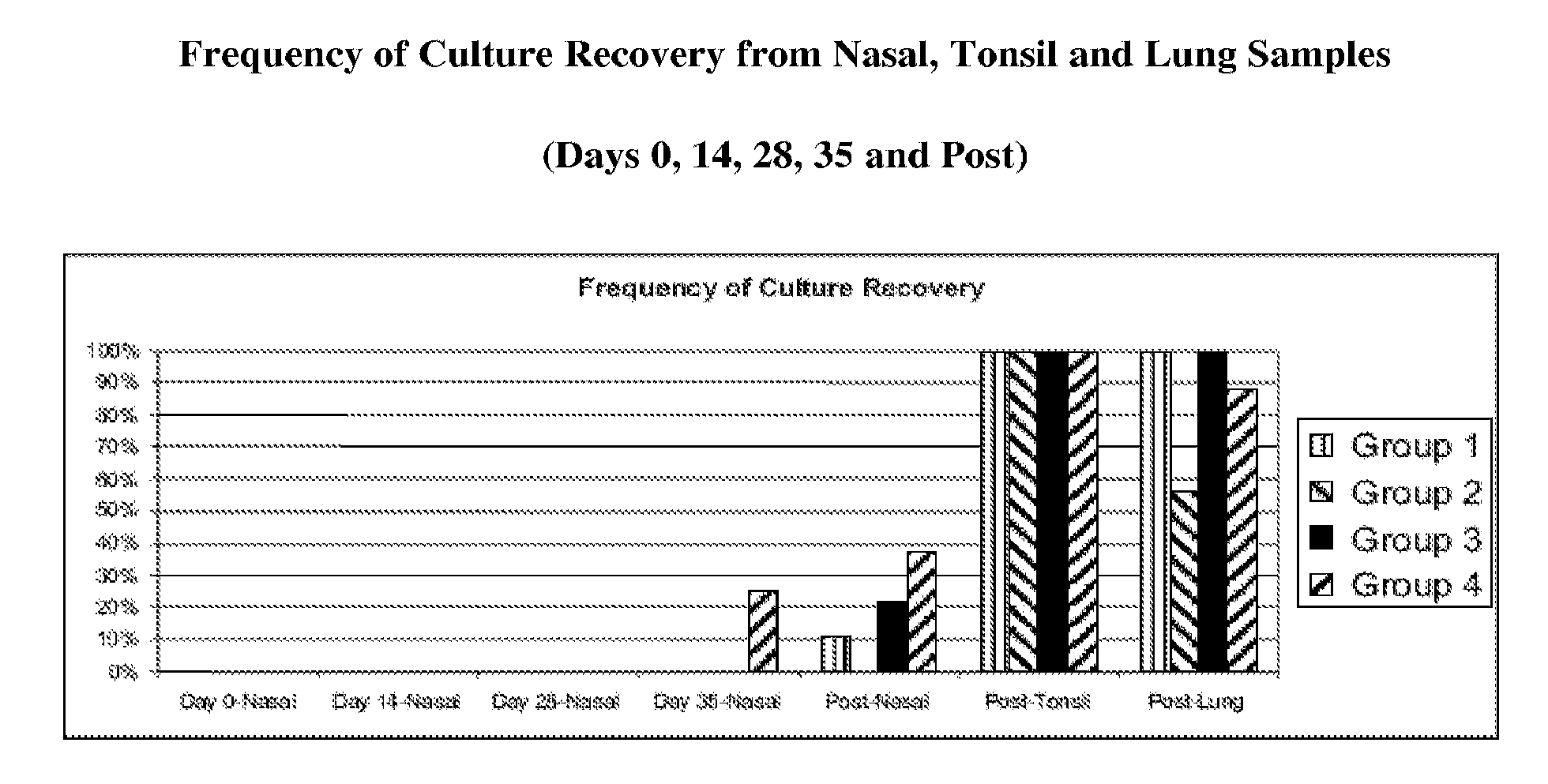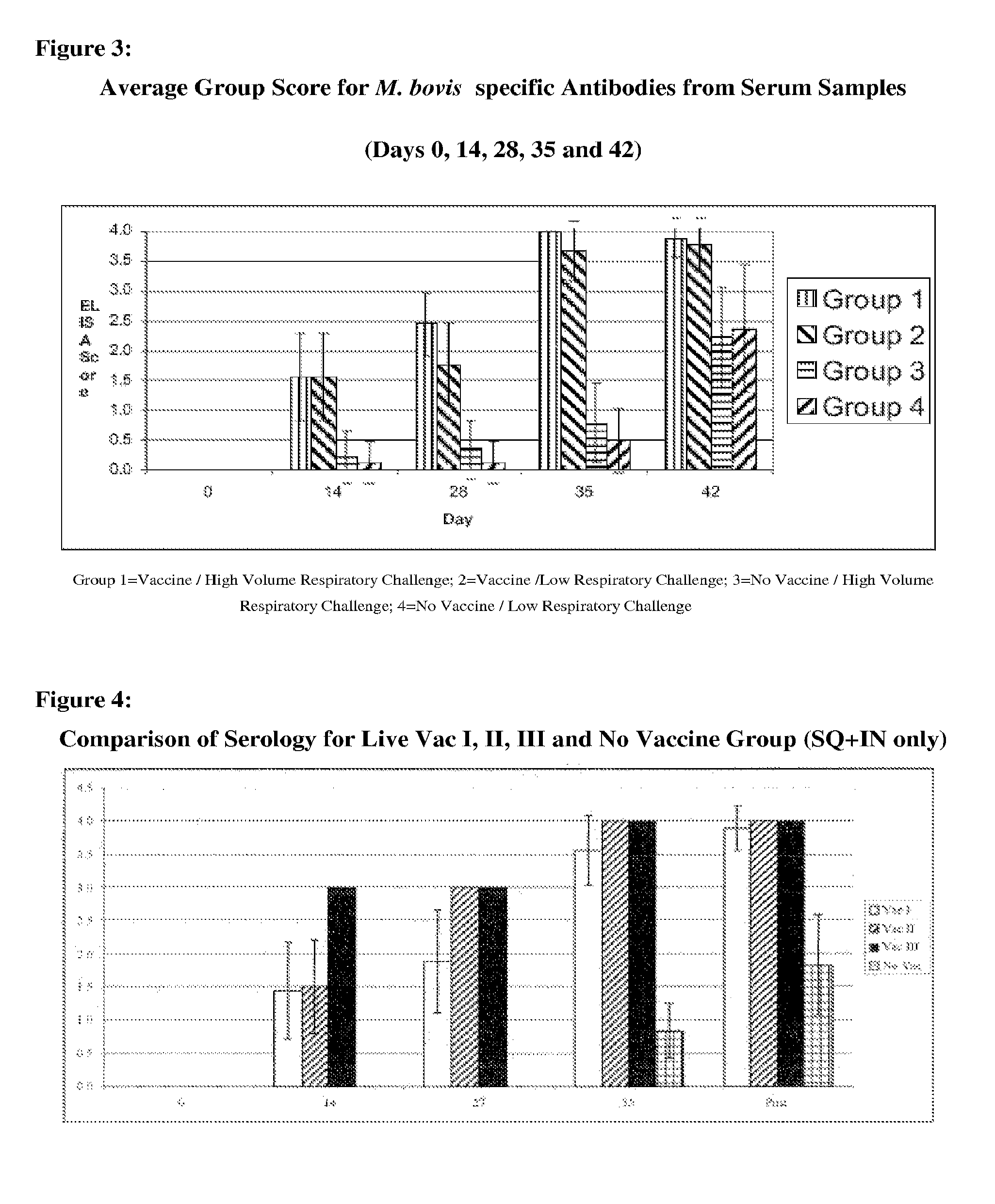Use of mycoplasma bovis antigen
a technology of mycoplasma and antigen, applied in the field of use of mycoplasma bovis antigen, can solve the problems of significant economic losses worldwide, organisms persisting in unsanitary, warm, moist environments, and i>mycoplasma /i> is difficult to treat, so as to achieve treatment and/or prophylaxis of infections, and cattle treatment and/or prophylaxis
- Summary
- Abstract
- Description
- Claims
- Application Information
AI Technical Summary
Benefits of technology
Problems solved by technology
Method used
Image
Examples
example 1
[0211]This Example assessed the efficacy of an experimental live M. bovis vaccine using two different challenge models in a target species.
Materials and Methods
[0212]Thirty-five colostrum deprived (CD) Holstein calves ranging in age from 4-8 weeks of age were used. All animals met the inclusion criteria, namely that they tested negative for M. bovis and were in good health at the time of the challenge. The calves were first randomly assigned to 1 of 4 groups. Groups 1-3 each contained 9 calves, and Group 4 contained 8 calves. Group 1 and 2 calves were vaccinated with Live Vac 1, which is a culture of M. bovis isolate 052823 passaged 106 times (05-2823-1A-3A P106+) (ATCC Designation No. PTA-8694) while Group 3 and 4 calves were vaccinated with media only. The vaccine isolate for Groups 1 and 2 was obtained from naturally occurring disease outbreak and then serially passaged 106 times in M. bovis appropriate media. The culture was grown 24±2 hours at 37° C. after inoculation with an a...
example 2
[0230]The purpose of this investigation was to determine the safety and efficacy of three live vaccine candidates.
Materials and Methods
[0231]The calves used for the study were 6±2 weeks of age and were divided into 6 groups. As shown in Table 7, group 1 was comprised of 10 animals, which were vaccinated with M. bovis Live Vaccine I on day 0 (D0) and D14 of the study. Group 1 was vaccinated with 2 ml subcutaneously and 2 ml intranasally on D0 and D14. Group 2 was comprised of 10 animals and was vaccinated with 2 ml of M. bovis Live Vaccine I subcutaneously on D0 and D14 of the study. Group 3 was comprised of 9 calves vaccinated with M. bovis Live Vaccine I on D0 and D14. Group 3 was vaccinated with 2 ml intranasally. Group 4 was a control and was not administered any vaccine. Group 5 was comprised of 2 calves that were vaccinated with M. bovis Live II vaccine. Group 5 was vaccinated with 2 ml subcutaneously and 2 ml intranasally on D0 and D14. Group 6 was comprised of two calves that...
example 3
[0247]This example describes the DNA fingerprinting process used to differentiate M. bovis strains by isolating, amplifying and detecting DNA.
Materials and Methods
[0248]Mycoplasma sp. isolates were used in the studies. Isolates were obtained from in-house sources or field isolates obtained from infected animals. Isolates were grown using a combination of Mycoplasma-selective agar and broth for 1-7 days. To isolate DNA, broth cultures were spun and pelleted. DNA from the pellet was then extracted (using the Qiagen DNeasy Tissue Kit and resuspended in molecular grade water). Genomic DNA was quantitated using Picogreen (Invitrogen). Primers were designed based on the known insertion sequences (transposable elements) present in the bacterial genome (Mycoplasma bovis). Outwardly facing primers were manually selected from the element ends (excluding the terminal repeat regions) at a Tm of 55-58 C. PCR reactions were then carried out using a multiplex PCR master mix (Qiagen Multiplex PCR K...
PUM
| Property | Measurement | Unit |
|---|---|---|
| Time | aaaaa | aaaaa |
| Volume | aaaaa | aaaaa |
| Volume | aaaaa | aaaaa |
Abstract
Description
Claims
Application Information
 Login to View More
Login to View More - R&D
- Intellectual Property
- Life Sciences
- Materials
- Tech Scout
- Unparalleled Data Quality
- Higher Quality Content
- 60% Fewer Hallucinations
Browse by: Latest US Patents, China's latest patents, Technical Efficacy Thesaurus, Application Domain, Technology Topic, Popular Technical Reports.
© 2025 PatSnap. All rights reserved.Legal|Privacy policy|Modern Slavery Act Transparency Statement|Sitemap|About US| Contact US: help@patsnap.com



